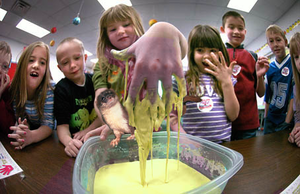User:Ghelae/Cheasel
Weese and Cheasels is a popular desert found in many areas of Britain and some states of America.
History[edit | edit source]
In the year 1910, cheese-making was a widespread industry, prevailent in such places as Cheddar, Edam and, surprisingly, Colorado. In all of these places, weasels were, at the time, at the top of the food chain. Humans, in an attempt to bring them down below them, invented "chease" ("Chewed with Ease"), a substance made out of milk, honey and cinnamon.
While this new food was only supposed to lure the weasels near the "chease faktories", into weasel traps, it instead attracted weasels from the area into the "chease" factories and into the deep vats of cheese, where the weasels met their deaths. They fell into the vats, slid down the sides and ended up in the hot "chease-micks" (cheese-mix). The weasels, trapped, sank under the "chease" and became solidified in it when it hardened. Thus, the cheasel was born.
In the newly created "cheese stores" ("cheese" being a mispelling of "chease", and the spelling still used today) the cheasels sold by the thousands, and weasels nearly became extinct. Fortunately, some animal rights protesters protested, so now we can make cheasels today instead of having to go for... cherrets... *shivers*
Recipe[edit | edit source]
While Wikipedia is not a cookbook, Uncyclopedia is, so, in this very article, we give you the recipe for cheasels.
Ingredients[edit | edit source]
- x starving, crazed, demented weasels.
- 1 cheese vat able to hold x+70 litres of molten cheese (preferably non-stick , so the weasels can't climb out). If there are no vats availiable, we at Uncyclopedoa recommend a cement mixer or jet engine.
- x+30 litres of molten cheese.
Method[edit | edit source]
- Preheat vat at cheese mark 2 (100°c)
- Fill vat with molten cheese. An experiment in 1936 showed that wensleydale works best, but cheddar is a cheaper, yet still effective, alternative.
- Mix molten cheese thoroughly for 3-5 minutes at cheese mark 4 (150°c), until cheeses goes a golden yellow colour.
- Let cheese cool to 50°c. Then it is ready.
- Drop weasel(s) into vat. It is recommended you place a white cloth over the vat, both to confuse weasels about the way out (weasels are very dumb animals) and to reflect any heat back in for optimum cheaseling temperature. You may wish to wear an apron, but it doesn't really matter as you can lick the molten cheese of your clothes. You probably would anyway. Read section below for what to do if any weasels manage to climb out.
- Eventually, the weasel screams should stop. Once that has happened, allow the vat to cool to room temperature.
- Slowly reheat the cheese up to cheese mark 2 again. With a net, fish for any odd lumps in the molten cheese. Then the rest of the cheese should be drained away.
- Voila! You have (a) cheasel(s)
Weese[edit | edit source]
While the early cheasel-makers were succesful, by the early 1940s weasels became stronger and more escaped from the vats. Due to evolution and natural selection, these stronger weasels reproduced more stronger weasels, and the cheasel industry almost came to a halt. So a solution had to be found.
In July 1943, an anonymous cheasel-maker discovered the solution. He thought that, as cheasels became mouldy over time, the escaping weasels could be used to "de-mould" the cheasels. However, while studying a weasel to check for the de-moulding chemical antisporadimicranine, he injected the compound antiweaseline into the weasel's leg, which caused the weaselpudge in the weasel to leak out, making the weasel crumble.
The cheasel-maker cleaned up the remains into a cup and left it on the side of his factory, before going for his lunch break. When he returned twenty minutes later, he discovered that he cleared the remains of the weasel into a cup of water, and the water reacted with the antisporadimicranine in the remains to form a paste which looked remarkably like cottage cheese. In a flash of inspiration, he called it "weasel cheese", which was then shortened to "weese".
Making weeze[edit | edit source]
- Squeeze pudge out of weasel.
- Ground weasel to powder.
- Pour 30 grams of powder into cup.
- Mix in 200 ml of water and a sprinkle of mint.
- Leave to settle for 30 minutes.
- Voila! You have Weese!
Then cover cheasel(s) with weese.

